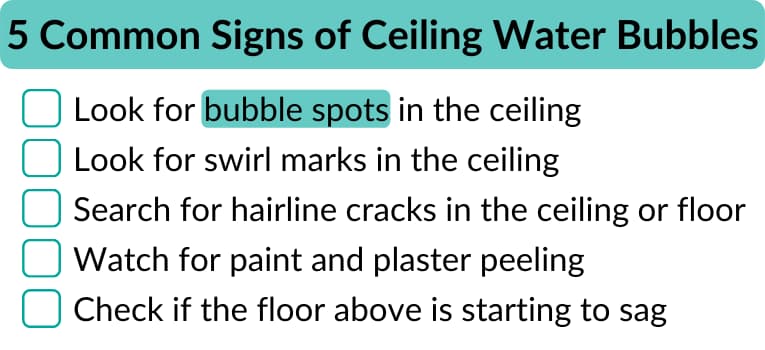Do you have a water bubble in your ceiling? The water bubble in your ceiling can be a common sign of a leak that is causing water to pool in the ceiling. If you don’t take care of it quickly, you could end up with a full-blown water damage repair situation on your hands.
In this article we will look at what the water bubble in your ceiling can tell you and what to do if your see it.
What Does a Water Bubble in Your Ceiling Mean?
When water leaks into your ceiling it can cause some considerable damage before you notice. If there are any bubbles in the paint or plaster of your ceiling, water has collected just below and started to pool which eventually causes the ceiling to bubble and sink.
If you see a bubble forming it is best to start repairs while it is small. Bigger bubbles can turn into water damage which will cause major problems and be expensive to repair.

5 Common Signs of Ceiling Water Bubbles
Keep an eye out for these common signs of ceiling water bubbles.
1 – In the paint or plaster of your ceiling, you may see a spot that looks as though it is bubbling from the rest of the smooth surface. A bubble forming can be a sign of water seeping down from below and pooling just out of sight.
2 – In the paint or plaster you may see swirl marks that look as though they are being drawn into a bubble in the ceiling. The appearance is similar to when you stir water with your hand and make whirlpools in the water. This is a previously undetected ceiling leak that is now pooling and causing a water stain.
3 – In the paint or plaster you may see little hairline cracks forming. If you have painted over them, this is an indication that water from further up has been leaking down and causing ceiling water damage for some time without your notice. It is best to get repairs started right away before the ceiling collapse.
4 – Paint or plaster could start to peel away. This might be because your ceiling is sagging due to water pooling above. If so, you should act quickly before the entire ceiling comes down.
5 – The floor of the room above you are in can also start to sag. This might be a sign that water has leaked into the area below and is causing damage there.
How To Fix A Water Bubble In The Ceiling
Tools Needed
- Moisture meter
- Drywall knife
- Wet vac or mobile sump pump
- Paint brush
- New paint
The first thing to do when you see a water bubble forming in your ceiling is to try and determine how much damage has been done and what caused it. If there were any plumbing or roofing repairs done recently, this might be where the leak started. Repair any pipes or roof leaks as soon as possible.
You can determine how much water is in your ceiling by using a moisture meter to test for dampness or by using a crack detector that will show you any hairline cracks that are present. If the water pooling in your ceiling is more than 10% of the floor area, you should consider hiring professional help to repair the area and check for mold growth.
To repair the water bubble in your ceiling you will need to pull off any loose paint or plaster around the area and cut out a section of drywall that is larger than the pooling area. If there are no hairline cracks, you can patch up the hole with drywall compound and sand it down smooth before painting over it.
The next step is to drain away any water that is still pooling in the ceiling. You can use a wet vac or sump pump to remove as much water and condensation as possible. Once the area has drained you will need to ventilate it to make sure there are no pockets of water left for mold and mildew to grow.
Finally, repaint over the new drywall and you’ll be water bubble free.
Contact a professional if the area is too big for you to repair or it has been damaged beyond 10% of the floors surface. You can find a handyman at your local hardware store or one that offers services through “Home Services” websites such as Porch, Angie’s List and Craigslist.
Frequently Asked Questions
Related PostsHow to Paint an Exposed Basement CeilingBasement Ceiling Height Guide and RequirementsDoes Bleach Stop Wood Rot?



![How to fix error 0xc000000e windows 10 2022 100 SOLVED 5 How to fix error 0xc000000e windows 10 2022: [100% SOLVED]](https://dreamcheeky.com/wp-content/uploads/2022/06/How-to-fix-error-0xc000000e-windows-10-2022-100-SOLVED.jpg)
![how to fix Error code 0xc0000001 2022 100 FIXED 6 how to fix Error code 0xc0000001 2022 :[100% FIXED]](https://dreamcheeky.com/wp-content/uploads/2022/06/how-to-fix-Error-code-0xc0000001-2022-100-FIXED.jpg)